Management and Business Contexts: An Annotated Bibliography
VerifiedAdded on 2023/05/29
|8
|2071
|273
Annotated Bibliography
AI Summary
This annotated bibliography explores key aspects of management and business contexts through summaries and analyses of five academic articles. The first article examines the relationship between organizational structure and business strategy, highlighting the importance of aligning structure with strategy for optimal performance. The second article discusses how organizational identity influences responses to external environmental pressures. The third article focuses on the role of control in managing risks within information systems projects. The fourth article investigates how human resource management practices enhance employee outcomes across different life stages. Finally, the fifth article explores the impact of organizational diversity programs on absenteeism, turnover, performance, and innovation across various cultures. Each annotation provides a concise overview of the article's methodology, findings, and relevance to the broader field of management and business.
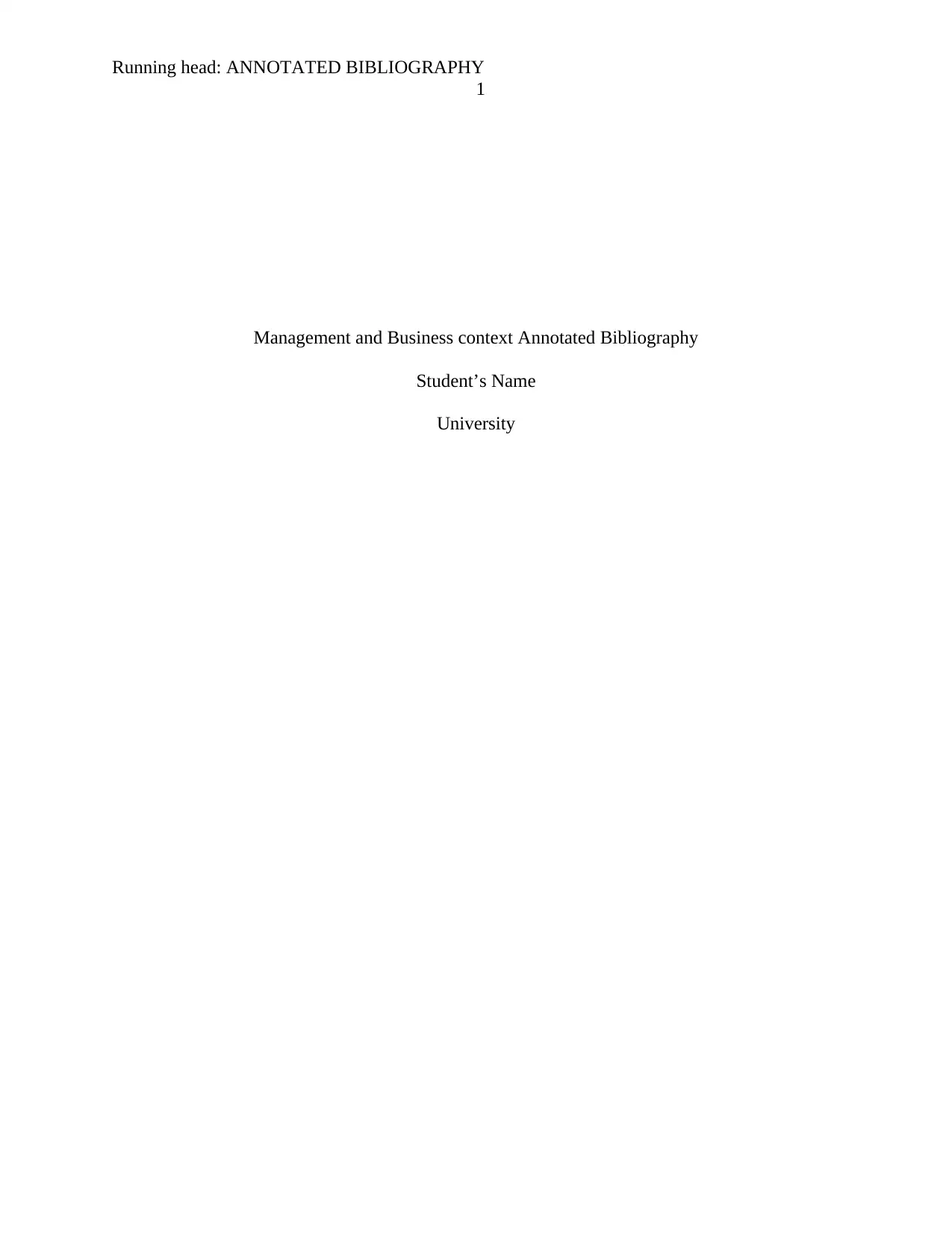
Running head: ANNOTATED BIBLIOGRAPHY
1
Management and Business context Annotated Bibliography
Student’s Name
University
1
Management and Business context Annotated Bibliography
Student’s Name
University
Paraphrase This Document
Need a fresh take? Get an instant paraphrase of this document with our AI Paraphraser
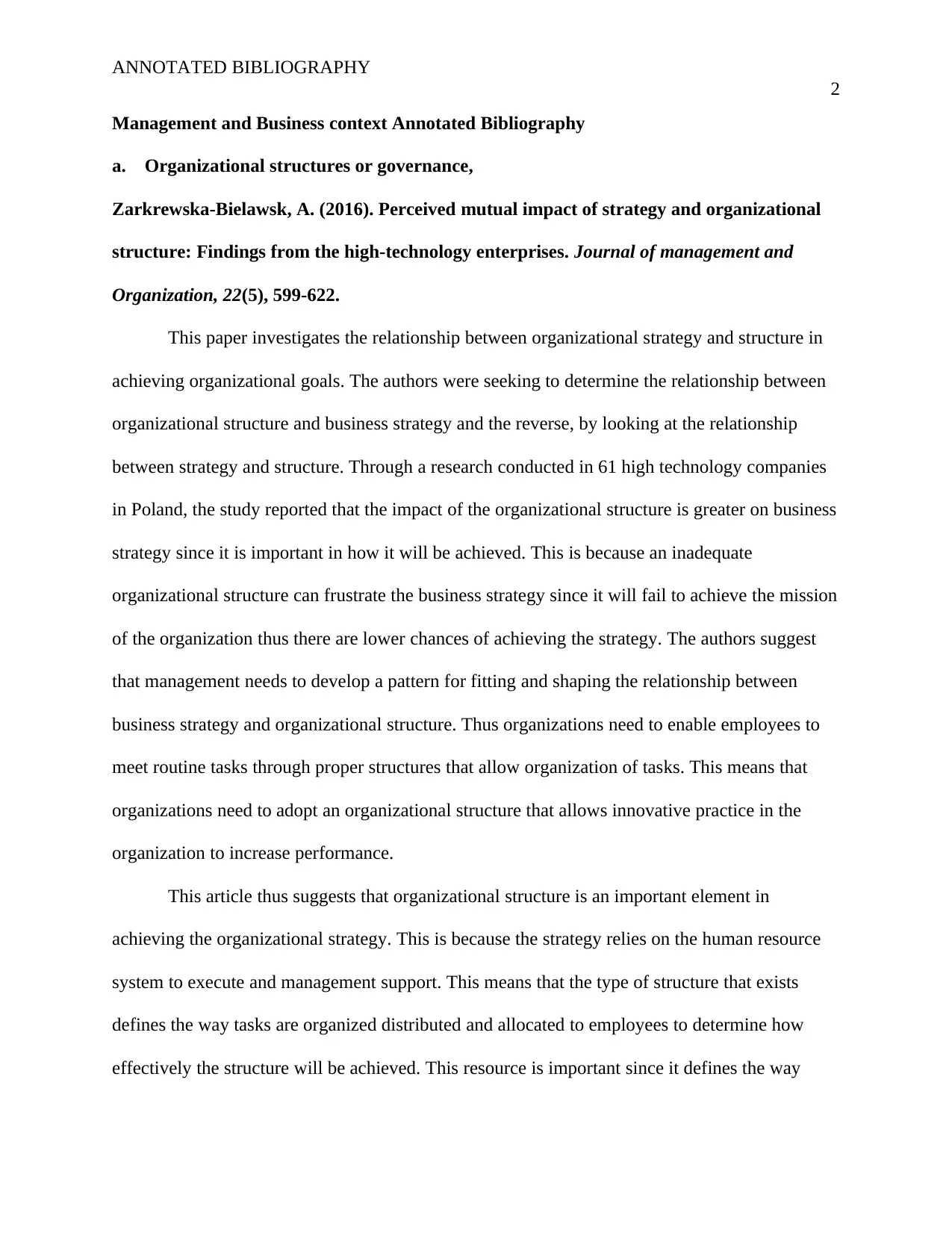
ANNOTATED BIBLIOGRAPHY
2
Management and Business context Annotated Bibliography
a. Organizational structures or governance,
Zarkrewska-Bielawsk, A. (2016). Perceived mutual impact of strategy and organizational
structure: Findings from the high-technology enterprises. Journal of management and
Organization, 22(5), 599-622.
This paper investigates the relationship between organizational strategy and structure in
achieving organizational goals. The authors were seeking to determine the relationship between
organizational structure and business strategy and the reverse, by looking at the relationship
between strategy and structure. Through a research conducted in 61 high technology companies
in Poland, the study reported that the impact of the organizational structure is greater on business
strategy since it is important in how it will be achieved. This is because an inadequate
organizational structure can frustrate the business strategy since it will fail to achieve the mission
of the organization thus there are lower chances of achieving the strategy. The authors suggest
that management needs to develop a pattern for fitting and shaping the relationship between
business strategy and organizational structure. Thus organizations need to enable employees to
meet routine tasks through proper structures that allow organization of tasks. This means that
organizations need to adopt an organizational structure that allows innovative practice in the
organization to increase performance.
This article thus suggests that organizational structure is an important element in
achieving the organizational strategy. This is because the strategy relies on the human resource
system to execute and management support. This means that the type of structure that exists
defines the way tasks are organized distributed and allocated to employees to determine how
effectively the structure will be achieved. This resource is important since it defines the way
2
Management and Business context Annotated Bibliography
a. Organizational structures or governance,
Zarkrewska-Bielawsk, A. (2016). Perceived mutual impact of strategy and organizational
structure: Findings from the high-technology enterprises. Journal of management and
Organization, 22(5), 599-622.
This paper investigates the relationship between organizational strategy and structure in
achieving organizational goals. The authors were seeking to determine the relationship between
organizational structure and business strategy and the reverse, by looking at the relationship
between strategy and structure. Through a research conducted in 61 high technology companies
in Poland, the study reported that the impact of the organizational structure is greater on business
strategy since it is important in how it will be achieved. This is because an inadequate
organizational structure can frustrate the business strategy since it will fail to achieve the mission
of the organization thus there are lower chances of achieving the strategy. The authors suggest
that management needs to develop a pattern for fitting and shaping the relationship between
business strategy and organizational structure. Thus organizations need to enable employees to
meet routine tasks through proper structures that allow organization of tasks. This means that
organizations need to adopt an organizational structure that allows innovative practice in the
organization to increase performance.
This article thus suggests that organizational structure is an important element in
achieving the organizational strategy. This is because the strategy relies on the human resource
system to execute and management support. This means that the type of structure that exists
defines the way tasks are organized distributed and allocated to employees to determine how
effectively the structure will be achieved. This resource is important since it defines the way
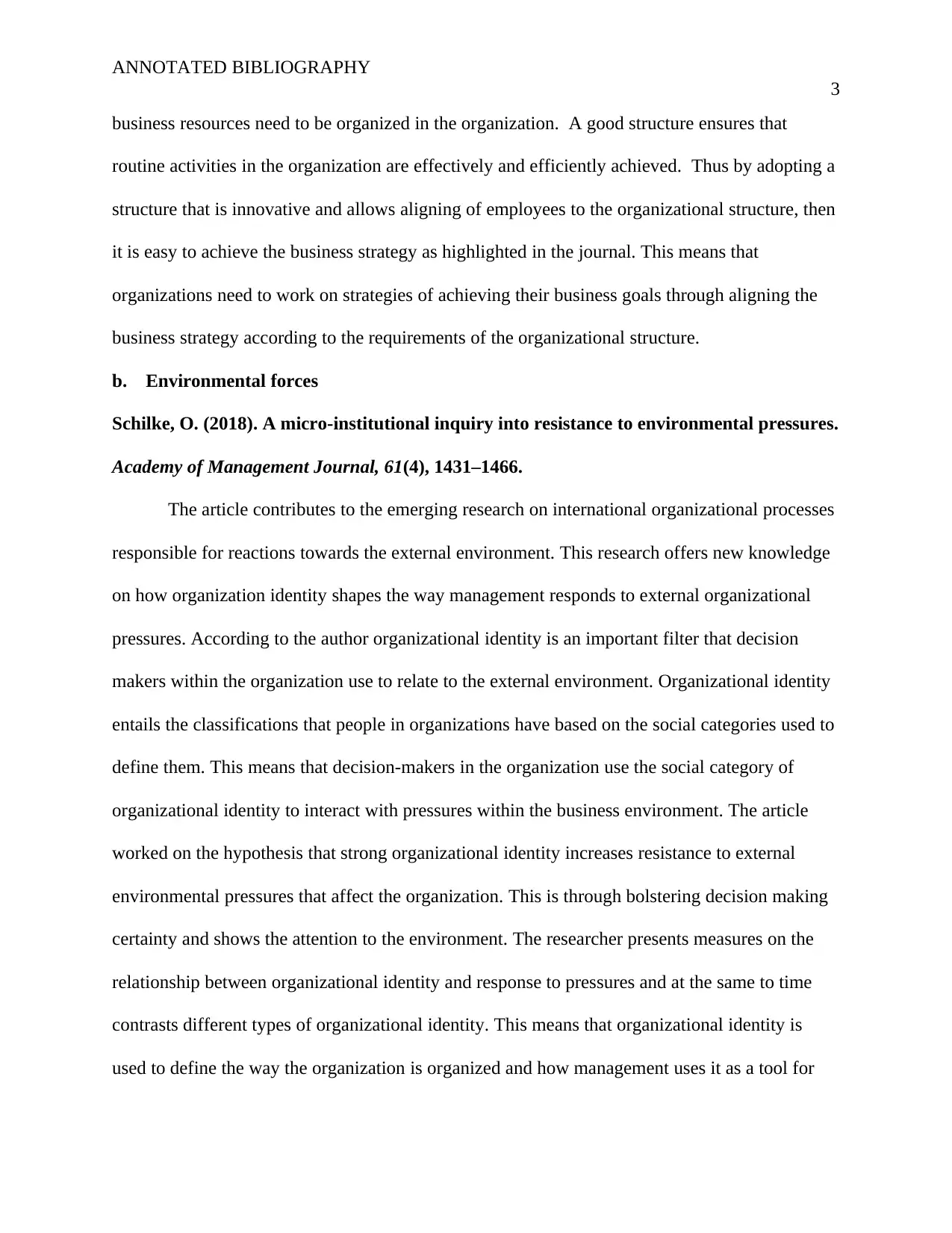
ANNOTATED BIBLIOGRAPHY
3
business resources need to be organized in the organization. A good structure ensures that
routine activities in the organization are effectively and efficiently achieved. Thus by adopting a
structure that is innovative and allows aligning of employees to the organizational structure, then
it is easy to achieve the business strategy as highlighted in the journal. This means that
organizations need to work on strategies of achieving their business goals through aligning the
business strategy according to the requirements of the organizational structure.
b. Environmental forces
Schilke, O. (2018). A micro-institutional inquiry into resistance to environmental pressures.
Academy of Management Journal, 61(4), 1431–1466.
The article contributes to the emerging research on international organizational processes
responsible for reactions towards the external environment. This research offers new knowledge
on how organization identity shapes the way management responds to external organizational
pressures. According to the author organizational identity is an important filter that decision
makers within the organization use to relate to the external environment. Organizational identity
entails the classifications that people in organizations have based on the social categories used to
define them. This means that decision-makers in the organization use the social category of
organizational identity to interact with pressures within the business environment. The article
worked on the hypothesis that strong organizational identity increases resistance to external
environmental pressures that affect the organization. This is through bolstering decision making
certainty and shows the attention to the environment. The researcher presents measures on the
relationship between organizational identity and response to pressures and at the same to time
contrasts different types of organizational identity. This means that organizational identity is
used to define the way the organization is organized and how management uses it as a tool for
3
business resources need to be organized in the organization. A good structure ensures that
routine activities in the organization are effectively and efficiently achieved. Thus by adopting a
structure that is innovative and allows aligning of employees to the organizational structure, then
it is easy to achieve the business strategy as highlighted in the journal. This means that
organizations need to work on strategies of achieving their business goals through aligning the
business strategy according to the requirements of the organizational structure.
b. Environmental forces
Schilke, O. (2018). A micro-institutional inquiry into resistance to environmental pressures.
Academy of Management Journal, 61(4), 1431–1466.
The article contributes to the emerging research on international organizational processes
responsible for reactions towards the external environment. This research offers new knowledge
on how organization identity shapes the way management responds to external organizational
pressures. According to the author organizational identity is an important filter that decision
makers within the organization use to relate to the external environment. Organizational identity
entails the classifications that people in organizations have based on the social categories used to
define them. This means that decision-makers in the organization use the social category of
organizational identity to interact with pressures within the business environment. The article
worked on the hypothesis that strong organizational identity increases resistance to external
environmental pressures that affect the organization. This is through bolstering decision making
certainty and shows the attention to the environment. The researcher presents measures on the
relationship between organizational identity and response to pressures and at the same to time
contrasts different types of organizational identity. This means that organizational identity is
used to define the way the organization is organized and how management uses it as a tool for
⊘ This is a preview!⊘
Do you want full access?
Subscribe today to unlock all pages.

Trusted by 1+ million students worldwide
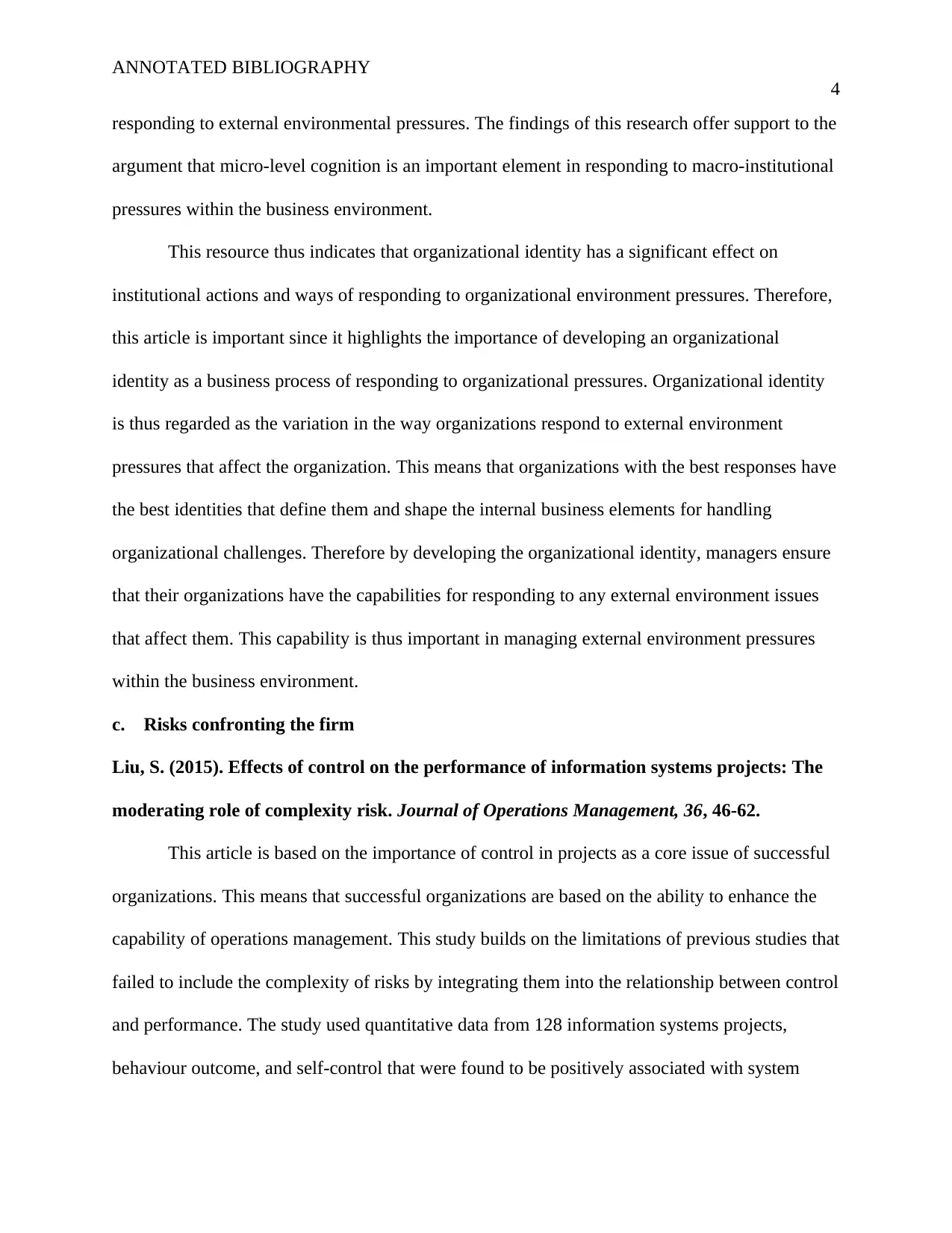
ANNOTATED BIBLIOGRAPHY
4
responding to external environmental pressures. The findings of this research offer support to the
argument that micro-level cognition is an important element in responding to macro-institutional
pressures within the business environment.
This resource thus indicates that organizational identity has a significant effect on
institutional actions and ways of responding to organizational environment pressures. Therefore,
this article is important since it highlights the importance of developing an organizational
identity as a business process of responding to organizational pressures. Organizational identity
is thus regarded as the variation in the way organizations respond to external environment
pressures that affect the organization. This means that organizations with the best responses have
the best identities that define them and shape the internal business elements for handling
organizational challenges. Therefore by developing the organizational identity, managers ensure
that their organizations have the capabilities for responding to any external environment issues
that affect them. This capability is thus important in managing external environment pressures
within the business environment.
c. Risks confronting the firm
Liu, S. (2015). Effects of control on the performance of information systems projects: The
moderating role of complexity risk. Journal of Operations Management, 36, 46-62.
This article is based on the importance of control in projects as a core issue of successful
organizations. This means that successful organizations are based on the ability to enhance the
capability of operations management. This study builds on the limitations of previous studies that
failed to include the complexity of risks by integrating them into the relationship between control
and performance. The study used quantitative data from 128 information systems projects,
behaviour outcome, and self-control that were found to be positively associated with system
4
responding to external environmental pressures. The findings of this research offer support to the
argument that micro-level cognition is an important element in responding to macro-institutional
pressures within the business environment.
This resource thus indicates that organizational identity has a significant effect on
institutional actions and ways of responding to organizational environment pressures. Therefore,
this article is important since it highlights the importance of developing an organizational
identity as a business process of responding to organizational pressures. Organizational identity
is thus regarded as the variation in the way organizations respond to external environment
pressures that affect the organization. This means that organizations with the best responses have
the best identities that define them and shape the internal business elements for handling
organizational challenges. Therefore by developing the organizational identity, managers ensure
that their organizations have the capabilities for responding to any external environment issues
that affect them. This capability is thus important in managing external environment pressures
within the business environment.
c. Risks confronting the firm
Liu, S. (2015). Effects of control on the performance of information systems projects: The
moderating role of complexity risk. Journal of Operations Management, 36, 46-62.
This article is based on the importance of control in projects as a core issue of successful
organizations. This means that successful organizations are based on the ability to enhance the
capability of operations management. This study builds on the limitations of previous studies that
failed to include the complexity of risks by integrating them into the relationship between control
and performance. The study used quantitative data from 128 information systems projects,
behaviour outcome, and self-control that were found to be positively associated with system
Paraphrase This Document
Need a fresh take? Get an instant paraphrase of this document with our AI Paraphraser
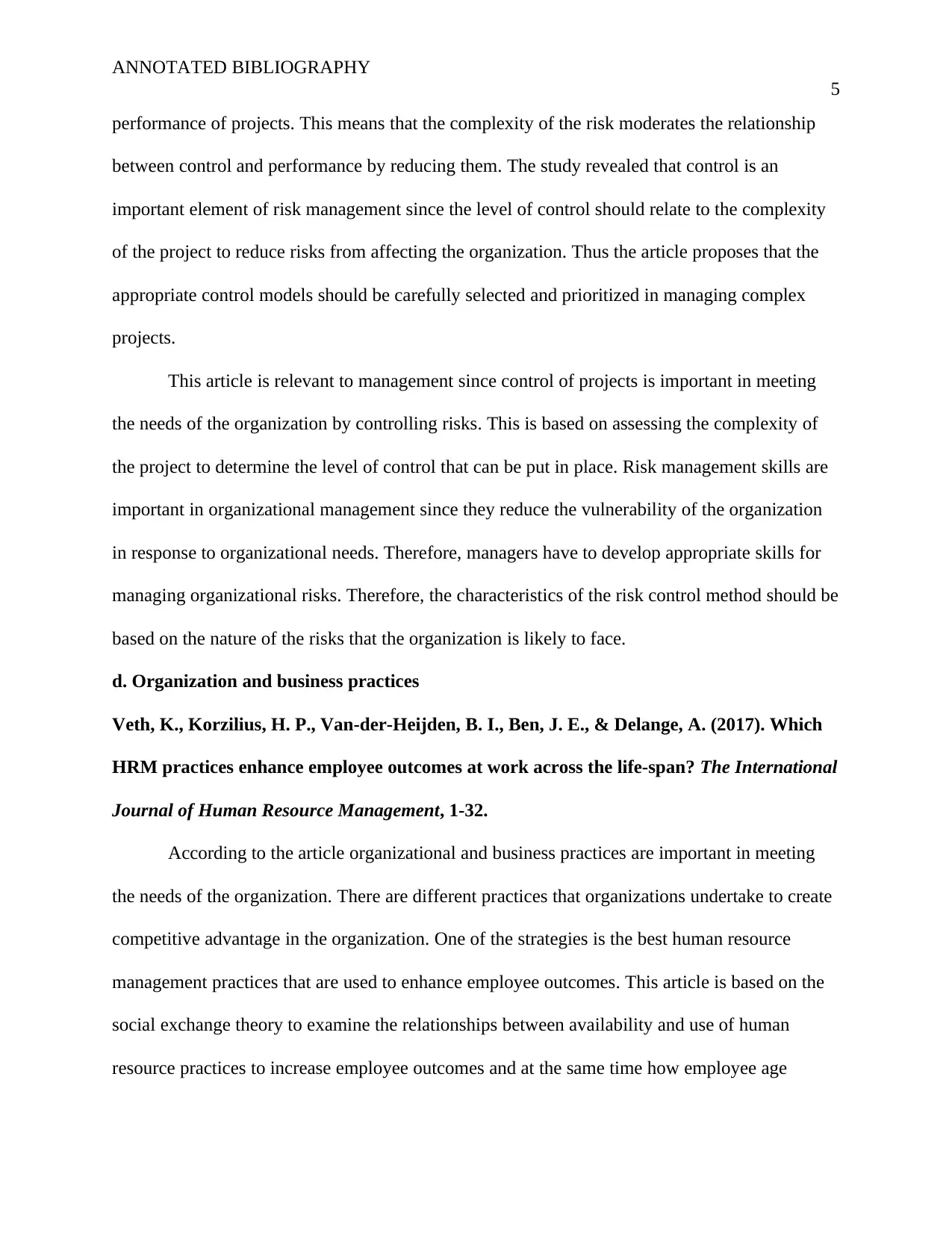
ANNOTATED BIBLIOGRAPHY
5
performance of projects. This means that the complexity of the risk moderates the relationship
between control and performance by reducing them. The study revealed that control is an
important element of risk management since the level of control should relate to the complexity
of the project to reduce risks from affecting the organization. Thus the article proposes that the
appropriate control models should be carefully selected and prioritized in managing complex
projects.
This article is relevant to management since control of projects is important in meeting
the needs of the organization by controlling risks. This is based on assessing the complexity of
the project to determine the level of control that can be put in place. Risk management skills are
important in organizational management since they reduce the vulnerability of the organization
in response to organizational needs. Therefore, managers have to develop appropriate skills for
managing organizational risks. Therefore, the characteristics of the risk control method should be
based on the nature of the risks that the organization is likely to face.
d. Organization and business practices
Veth, K., Korzilius, H. P., Van-der-Heijden, B. I., Ben, J. E., & Delange, A. (2017). Which
HRM practices enhance employee outcomes at work across the life-span? The International
Journal of Human Resource Management, 1-32.
According to the article organizational and business practices are important in meeting
the needs of the organization. There are different practices that organizations undertake to create
competitive advantage in the organization. One of the strategies is the best human resource
management practices that are used to enhance employee outcomes. This article is based on the
social exchange theory to examine the relationships between availability and use of human
resource practices to increase employee outcomes and at the same time how employee age
5
performance of projects. This means that the complexity of the risk moderates the relationship
between control and performance by reducing them. The study revealed that control is an
important element of risk management since the level of control should relate to the complexity
of the project to reduce risks from affecting the organization. Thus the article proposes that the
appropriate control models should be carefully selected and prioritized in managing complex
projects.
This article is relevant to management since control of projects is important in meeting
the needs of the organization by controlling risks. This is based on assessing the complexity of
the project to determine the level of control that can be put in place. Risk management skills are
important in organizational management since they reduce the vulnerability of the organization
in response to organizational needs. Therefore, managers have to develop appropriate skills for
managing organizational risks. Therefore, the characteristics of the risk control method should be
based on the nature of the risks that the organization is likely to face.
d. Organization and business practices
Veth, K., Korzilius, H. P., Van-der-Heijden, B. I., Ben, J. E., & Delange, A. (2017). Which
HRM practices enhance employee outcomes at work across the life-span? The International
Journal of Human Resource Management, 1-32.
According to the article organizational and business practices are important in meeting
the needs of the organization. There are different practices that organizations undertake to create
competitive advantage in the organization. One of the strategies is the best human resource
management practices that are used to enhance employee outcomes. This article is based on the
social exchange theory to examine the relationships between availability and use of human
resource practices to increase employee outcomes and at the same time how employee age
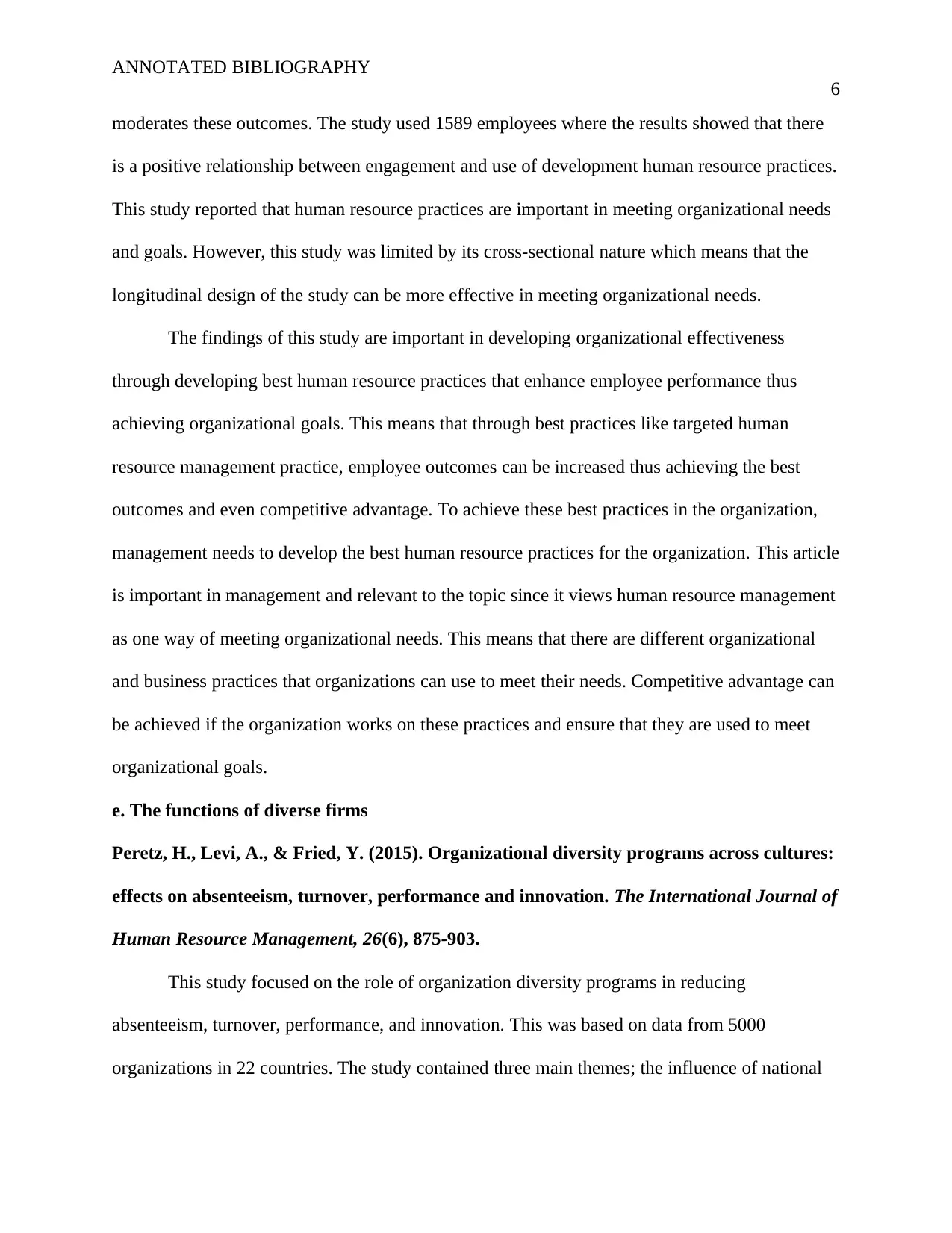
ANNOTATED BIBLIOGRAPHY
6
moderates these outcomes. The study used 1589 employees where the results showed that there
is a positive relationship between engagement and use of development human resource practices.
This study reported that human resource practices are important in meeting organizational needs
and goals. However, this study was limited by its cross-sectional nature which means that the
longitudinal design of the study can be more effective in meeting organizational needs.
The findings of this study are important in developing organizational effectiveness
through developing best human resource practices that enhance employee performance thus
achieving organizational goals. This means that through best practices like targeted human
resource management practice, employee outcomes can be increased thus achieving the best
outcomes and even competitive advantage. To achieve these best practices in the organization,
management needs to develop the best human resource practices for the organization. This article
is important in management and relevant to the topic since it views human resource management
as one way of meeting organizational needs. This means that there are different organizational
and business practices that organizations can use to meet their needs. Competitive advantage can
be achieved if the organization works on these practices and ensure that they are used to meet
organizational goals.
e. The functions of diverse firms
Peretz, H., Levi, A., & Fried, Y. (2015). Organizational diversity programs across cultures:
effects on absenteeism, turnover, performance and innovation. The International Journal of
Human Resource Management, 26(6), 875-903.
This study focused on the role of organization diversity programs in reducing
absenteeism, turnover, performance, and innovation. This was based on data from 5000
organizations in 22 countries. The study contained three main themes; the influence of national
6
moderates these outcomes. The study used 1589 employees where the results showed that there
is a positive relationship between engagement and use of development human resource practices.
This study reported that human resource practices are important in meeting organizational needs
and goals. However, this study was limited by its cross-sectional nature which means that the
longitudinal design of the study can be more effective in meeting organizational needs.
The findings of this study are important in developing organizational effectiveness
through developing best human resource practices that enhance employee performance thus
achieving organizational goals. This means that through best practices like targeted human
resource management practice, employee outcomes can be increased thus achieving the best
outcomes and even competitive advantage. To achieve these best practices in the organization,
management needs to develop the best human resource practices for the organization. This article
is important in management and relevant to the topic since it views human resource management
as one way of meeting organizational needs. This means that there are different organizational
and business practices that organizations can use to meet their needs. Competitive advantage can
be achieved if the organization works on these practices and ensure that they are used to meet
organizational goals.
e. The functions of diverse firms
Peretz, H., Levi, A., & Fried, Y. (2015). Organizational diversity programs across cultures:
effects on absenteeism, turnover, performance and innovation. The International Journal of
Human Resource Management, 26(6), 875-903.
This study focused on the role of organization diversity programs in reducing
absenteeism, turnover, performance, and innovation. This was based on data from 5000
organizations in 22 countries. The study contained three main themes; the influence of national
⊘ This is a preview!⊘
Do you want full access?
Subscribe today to unlock all pages.

Trusted by 1+ million students worldwide
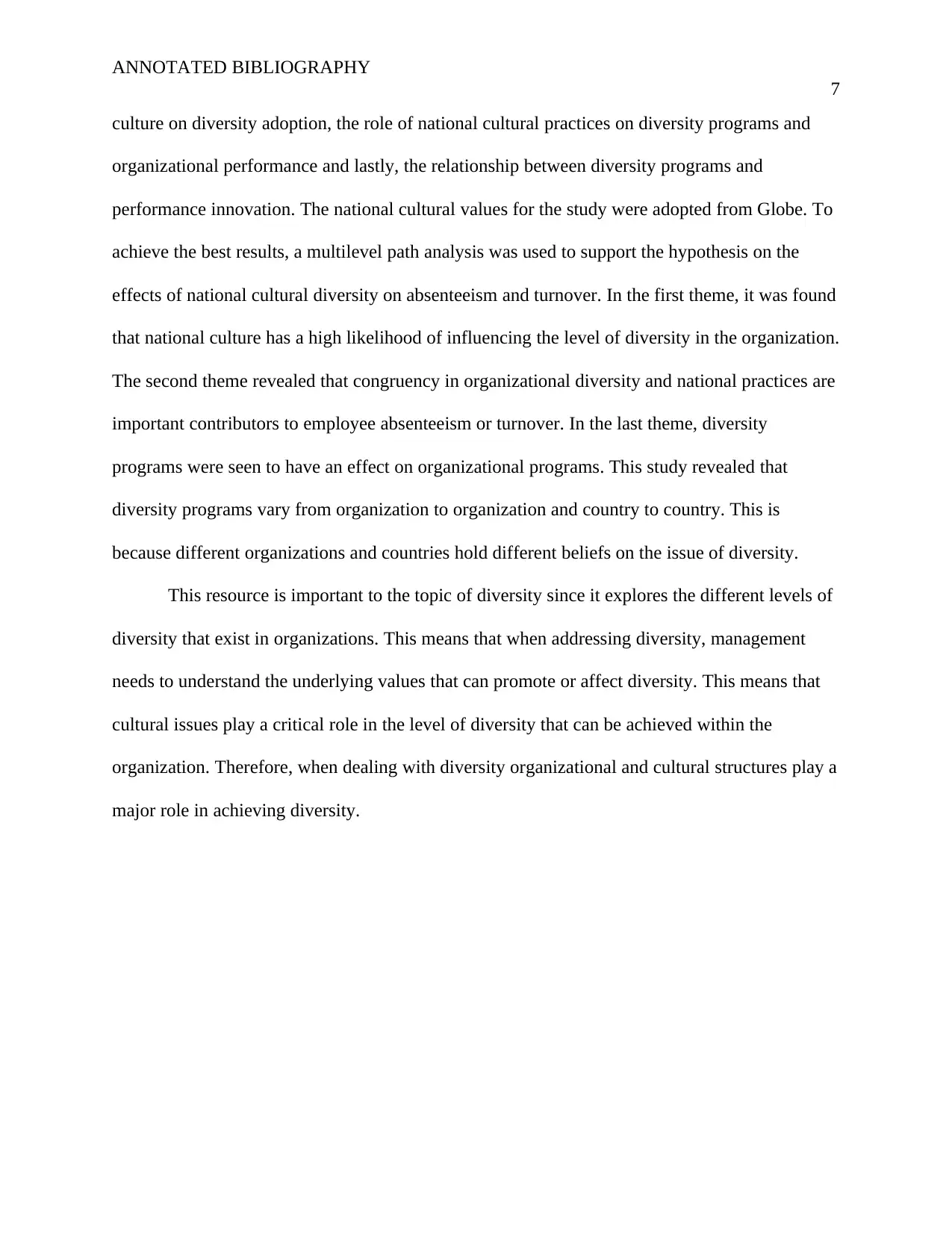
ANNOTATED BIBLIOGRAPHY
7
culture on diversity adoption, the role of national cultural practices on diversity programs and
organizational performance and lastly, the relationship between diversity programs and
performance innovation. The national cultural values for the study were adopted from Globe. To
achieve the best results, a multilevel path analysis was used to support the hypothesis on the
effects of national cultural diversity on absenteeism and turnover. In the first theme, it was found
that national culture has a high likelihood of influencing the level of diversity in the organization.
The second theme revealed that congruency in organizational diversity and national practices are
important contributors to employee absenteeism or turnover. In the last theme, diversity
programs were seen to have an effect on organizational programs. This study revealed that
diversity programs vary from organization to organization and country to country. This is
because different organizations and countries hold different beliefs on the issue of diversity.
This resource is important to the topic of diversity since it explores the different levels of
diversity that exist in organizations. This means that when addressing diversity, management
needs to understand the underlying values that can promote or affect diversity. This means that
cultural issues play a critical role in the level of diversity that can be achieved within the
organization. Therefore, when dealing with diversity organizational and cultural structures play a
major role in achieving diversity.
7
culture on diversity adoption, the role of national cultural practices on diversity programs and
organizational performance and lastly, the relationship between diversity programs and
performance innovation. The national cultural values for the study were adopted from Globe. To
achieve the best results, a multilevel path analysis was used to support the hypothesis on the
effects of national cultural diversity on absenteeism and turnover. In the first theme, it was found
that national culture has a high likelihood of influencing the level of diversity in the organization.
The second theme revealed that congruency in organizational diversity and national practices are
important contributors to employee absenteeism or turnover. In the last theme, diversity
programs were seen to have an effect on organizational programs. This study revealed that
diversity programs vary from organization to organization and country to country. This is
because different organizations and countries hold different beliefs on the issue of diversity.
This resource is important to the topic of diversity since it explores the different levels of
diversity that exist in organizations. This means that when addressing diversity, management
needs to understand the underlying values that can promote or affect diversity. This means that
cultural issues play a critical role in the level of diversity that can be achieved within the
organization. Therefore, when dealing with diversity organizational and cultural structures play a
major role in achieving diversity.
Paraphrase This Document
Need a fresh take? Get an instant paraphrase of this document with our AI Paraphraser
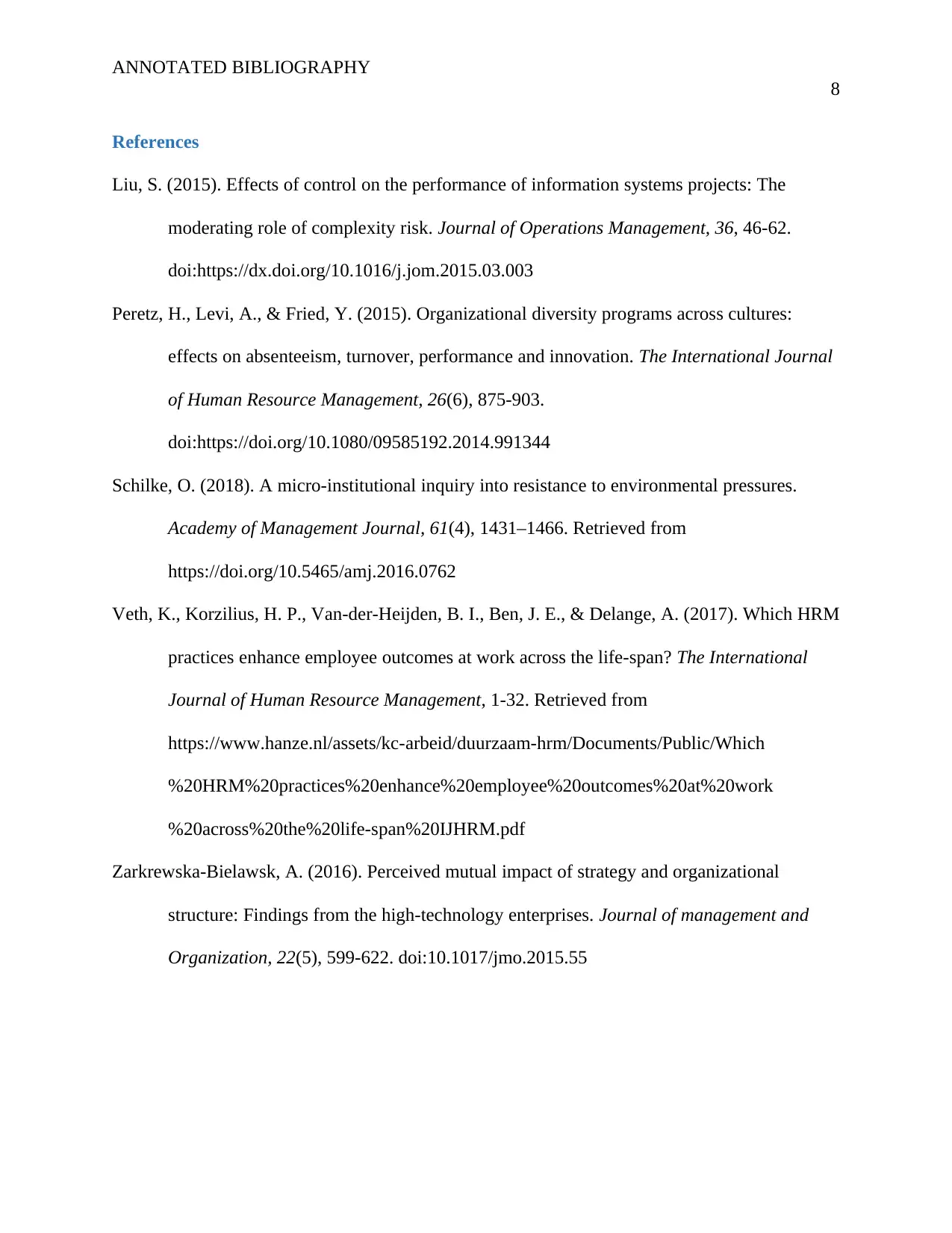
ANNOTATED BIBLIOGRAPHY
8
References
Liu, S. (2015). Effects of control on the performance of information systems projects: The
moderating role of complexity risk. Journal of Operations Management, 36, 46-62.
doi:https://dx.doi.org/10.1016/j.jom.2015.03.003
Peretz, H., Levi, A., & Fried, Y. (2015). Organizational diversity programs across cultures:
effects on absenteeism, turnover, performance and innovation. The International Journal
of Human Resource Management, 26(6), 875-903.
doi:https://doi.org/10.1080/09585192.2014.991344
Schilke, O. (2018). A micro-institutional inquiry into resistance to environmental pressures.
Academy of Management Journal, 61(4), 1431–1466. Retrieved from
https://doi.org/10.5465/amj.2016.0762
Veth, K., Korzilius, H. P., Van-der-Heijden, B. I., Ben, J. E., & Delange, A. (2017). Which HRM
practices enhance employee outcomes at work across the life-span? The International
Journal of Human Resource Management, 1-32. Retrieved from
https://www.hanze.nl/assets/kc-arbeid/duurzaam-hrm/Documents/Public/Which
%20HRM%20practices%20enhance%20employee%20outcomes%20at%20work
%20across%20the%20life-span%20IJHRM.pdf
Zarkrewska-Bielawsk, A. (2016). Perceived mutual impact of strategy and organizational
structure: Findings from the high-technology enterprises. Journal of management and
Organization, 22(5), 599-622. doi:10.1017/jmo.2015.55
8
References
Liu, S. (2015). Effects of control on the performance of information systems projects: The
moderating role of complexity risk. Journal of Operations Management, 36, 46-62.
doi:https://dx.doi.org/10.1016/j.jom.2015.03.003
Peretz, H., Levi, A., & Fried, Y. (2015). Organizational diversity programs across cultures:
effects on absenteeism, turnover, performance and innovation. The International Journal
of Human Resource Management, 26(6), 875-903.
doi:https://doi.org/10.1080/09585192.2014.991344
Schilke, O. (2018). A micro-institutional inquiry into resistance to environmental pressures.
Academy of Management Journal, 61(4), 1431–1466. Retrieved from
https://doi.org/10.5465/amj.2016.0762
Veth, K., Korzilius, H. P., Van-der-Heijden, B. I., Ben, J. E., & Delange, A. (2017). Which HRM
practices enhance employee outcomes at work across the life-span? The International
Journal of Human Resource Management, 1-32. Retrieved from
https://www.hanze.nl/assets/kc-arbeid/duurzaam-hrm/Documents/Public/Which
%20HRM%20practices%20enhance%20employee%20outcomes%20at%20work
%20across%20the%20life-span%20IJHRM.pdf
Zarkrewska-Bielawsk, A. (2016). Perceived mutual impact of strategy and organizational
structure: Findings from the high-technology enterprises. Journal of management and
Organization, 22(5), 599-622. doi:10.1017/jmo.2015.55
1 out of 8
Related Documents
Your All-in-One AI-Powered Toolkit for Academic Success.
+13062052269
info@desklib.com
Available 24*7 on WhatsApp / Email
![[object Object]](/_next/static/media/star-bottom.7253800d.svg)
Unlock your academic potential
Copyright © 2020–2025 A2Z Services. All Rights Reserved. Developed and managed by ZUCOL.
